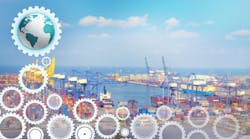Pandemic Reaction: What Supply Chains Did Right and Where They Can Improve
Contingency plans and risk assessments are an integral part of supply chain management; however, a global pandemic is beyond the scope of most plans. The complications that arose from companies facing supply chain disturbances at the same time that consumers' expectations increased became overwhelming.
“Prior to the pandemic, most consumers were not aware of supply chain issues,” explains Abe Eshkenazi, CEO of the Association for Supply Chain Management (ASCM). “Before the pandemic, we had a very efficient supply chain, as just-in-time was the hallmark of every industry. Consumers were provided with high-quality goods in a variety of choices at a reasonable cost. But no one really understood how this happened.”
Of course, that changed as shortages, both real and those created, became apparent. While raw materials and parts became unavailable due to production stoppages and goods such as autos could not be produced, other disruptions were man-made. “We didn’t change our consumption of food or even toilet paper, just where the products were being delivered,” says Eshkenazi. “We need to have a better understanding of the harmonization and sequencing of the supply chains.”
Data-Driven Decisions
Changing locations and lot sizes is a major shift for manufacturers, distribution centers, and consumers. Consumer expectations, due to the Amazon effect which has made next-day delivery the normal, did not adjust, at first, to this new model. In fact, consumers began to hoard products, which created surges that were hard for the supply chain to meet.
The distribution model was not prepared for this change at first, says Eshkenazi. “How companies responded was dependent on the data that was available. Some responded well and others didn’t, and this is where we can draw the line between what the data points told us. Data was the differentiator."
This point was corroborated by a study that ASCM participated in with The Economist called “The Resilient Supply Chain Benchmark – Ready for Anything? Turbulence and the Resilience Imperative.” The report concluded that during the pandemic, “many companies found that their business continuity plans lacked information about less critical processes which were magnified in importance in the middle of a prolonged disruption happening everywhere at once.”
The lack of end-to-end visibility was a reason that many companies were left vulnerable during the pandemic. The study found that about half of the companies benchmarked for this study were relying on internal data which was often based on outdated datasets or information that were siloed from other parts of the company. The result was that they were limited in their ability to “calculate how disruption will unfold across supply chains and business units. High performers build an ‘outside-in’ picture through the integration of supply chain partners into demand forecasting and planning as well as systems that provide real-time data.”
Better analytics helped some companies, Eshkenazi notes. Many of the large companies had already invested in the technology necessary to both produce and understand data. The technologies that Eshkenazi finds most useful for supply chain purposes are blockchain, Internet of Things (IoT) and artificial intelligence (AI). Those technologies can enable companies to gather data further down the supply chain. What was lacking in trying to react to the pandemic was the lack of information from Tier 2 and 3 suppliers. “Those that had data further down the supply chain and knew that change was happening could better manage both in terms of sourcing and manufacturing,” explains Eshkenazi. In fact, he points out, when companies had that information, they paid their suppliers in order to keep them in business.
Pandemic Effect on Talent Pipeline
The need for more data in the supply chain to manage the pandemic and other future disruptions highlights what has been an industry problem for some time – lack of employees with the right skill set. “Prior to the pandemic for every opening it was very hard to find even one qualified candidate,” says Eshkenazi. “And this brings up an important point and one I make to the companies I talk with, which is: Are you investing in your talent at the same level you are investing in the technology? Because you are going to need competent people to discern what is the important data from the piles of information companies are collecting.”
One solution to attracting people to the industry is to let future employees know that this field pays well and is a good career choice. In a 2020 Salary Survey done by ASCM, supply chain professionals holding a bachelor’s degree earned a median salary of $78,750. That salary is substantially higher, by 24%, than the national median salary. For employees who have an associate degree the median salary of $67,000 is also much higher than the national median salary.
In addition to a good salary, the field offers a good career path. Asked about their career outlook, 88% said they have a positive one and 85% said they would recommend this career path to others.
These opportunities should be explained to children as young as middle school, advises Eshkenazi, since by the time they reach high school many have already made their career choices. And since there is no single job called "supply chain management," the industry needs to better explain this career. But now is a great time to do this, says Eshkenazi, with awareness of the importance of the field at an all-time high.
Global Not Local Supply Chain
Also highlighted by the greater awareness of how supply chains operate is the global nature of the supply chain. “The challenge we face is having a greater understanding that the supply chain is a global issue and not a local one,” says Eshkenazi. “As we move forward in dealing with the pandemic and other disruptions that will arise, we need to understand that we are a global community. And this is great news since the supply chain could be that vehicle that can bring countries and people together.”




